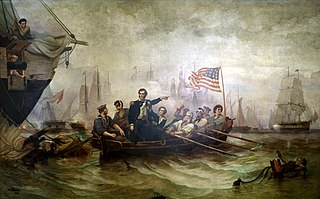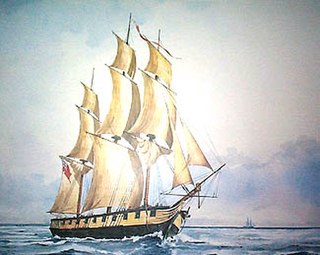Related Research Articles

The Battle of Lake Erie, also known as the Battle of Put-in-Bay, was fought on 10 September 1813, on Lake Erie off the shore of Ohio during the War of 1812. Nine vessels of the United States Navy defeated and captured six vessels of the British Royal Navy. This ensured American control of the lake for the rest of the war, which in turn allowed the Americans to recover Detroit and win the Battle of the Thames to break the Indian confederation of Tecumseh. It was one of the biggest naval battles of the War of 1812.

The Battle of Lundy's Lane, also known as the Battle of Niagara, was a battle fought on 25 July 1814, during the War of 1812, between an invading American army and a British and Canadian army near present-day Niagara Falls, Ontario. It was one of the bloodiest battles of the war, and one of the deadliest battles fought in Canada, with approximately 1,720 casualties including 258 killed.

The Rush–Bagot Treaty or Rush–Bagot Disarmament was a treaty between the United States and Great Britain limiting naval armaments on the Great Lakes and Lake Champlain, following the War of 1812. It was ratified by the United States Senate on April 16, 1818, and was confirmed by Canada, following Confederation in 1867.

HMS Detroit was a 20-gun sloop of the Royal Navy, launched in July 1813 and serving on Lake Erie during the War of 1812. She was the most powerful British ship in the Lake Erie squadron until the Americans captured her during the Battle of Lake Erie on 10 September 1813. Detroit was commissioned into the United States Navy as its first USS Detroit. However, she was so damaged that the sloop took no further part in the war. Postwar, Detroit was sunk for preservation at Misery Bay off Presque Isle until 1833, when she was refloated and converted for commercial service. In 1841, Detroit was reduced to a hulk at Buffalo, New York where she was purchased with the intent of sending her over Niagara Falls. The plan went awry and Detroit ran aground on a shoal before the falls and broke up.
USS Jefferson was a brig in the United States Navy during the War of 1812. She was named for Founding Father and third U.S. president Thomas Jefferson. Jefferson was built at Sackett's Harbor, New York, for service in Commodore Isaac Chauncey's fleet on Lake Ontario and launched 7 April 1814. She was manned by a crew from sloop of war Erie which had been laid up at Baltimore because of the British blockade of Chesapeake Bay. Comdr. Charles G. Ridgeley was her captain. Notable Master Gunner George Marshall a warrant officer, was responsible for the ship's artillery. Marshall was also from the sloop of war Erie.
USS Julia was a schooner in the United States Navy during the War of 1812. Initially the privately-owned schooner Julia, she was captured at the onset of the war by armed boats looking for violators of President James Madison's embargo of trade with the British. Purchased by the United States Navy, the vessel was armed with two guns and made part of the squadron on Lake Ontario. Julia took part in the Battle of York and the Battle of Fort George. In August 1813, the schooner was captured by the Royal Navy after failing to execute a turn and was put in service as HMS Confiance. The vessel continued as a warship in British service for a couple of weeks before being converted to a troop transport. In October, Confiance was recaptured by the Americans and renamed Julia. No longer considered capable as a warship, the vessel was retired from service.
USS Lady of the Lake was a small schooner in the United States Navy during the War of 1812. She was built by Henry Eckford of Sacketts Harbor, New York, during the summer and winter of 1812-13, launched 6 April 1813 and entered service 13 days later, Sailing Master Flinn in command.

USS General Pike was a corvette in the United States Navy, which took part in Engagements on Lake Ontario during the Anglo-American War of 1812. She was launched in June 1813 and took part in several indecisive battles on the Great Lakes. She was laid up at the end of the war and was sold in 1825.

HMS Royal George was a British 20-gun wooden sloop of the Provincial Marine, and subsequently, the Royal Navy, operating on Lake Ontario during the War of 1812. The vessel took part in several Engagements on Lake Ontario and was the flagship of the Provincial Marine at the First Battle of Sackett's Harbor. In 1814, the vessel was renamed Niagara. Following the war, the sloop was converted to a transport and sold in 1837.

HMS St Lawrence was a 102-gun first-rate wooden warship of the Royal Navy that served on Lake Ontario during the War of 1812. Built on the lake at the Royal Navy dockyard in Kingston, Ontario, she was the only Royal Navy ship of the line ever to be launched and operated entirely in fresh water. Constructed in 1814, the ship's arrival on the lake ended all naval action and St Lawrence finished the war having never gone into battle. Following the war, the vessel was laid up, eventually being sold in 1832 to private interests. The ship was later sunk and is now a recreational dive spot.
USS Somers was a schooner, formerly Catherine, purchased by the United States Navy in 1812. She was purchased for $5,500 from Jacob Townsend, a pioneer and one of the first settlers of Lewiston, New York and purveyor of goods on the Great Lakes. She fought in the War of 1812 under the command of Commodore Oliver Hazard Perry on Lake Erie and Lake Huron, and took part in the capture of the British Squadron on 10 September 1813. She was captured by the British in 1814, and taken into service as HMS Huron.

HMS Princess Charlotte, later HMS Burlington, was a 42-gun fifth-rate frigate of the Royal Navy built in 1814, during the War of 1812 at the Kingston Royal Naval Dockyard in Kingston, Ontario. She had originally been built as Vittoria, but was renamed before being launched. She was constructed to a design by George Record, and was built under a private contract by Master shipwright John Goudie. She served on Lake Ontario, having been commissioned at Oswego on 5 May 1814 under Captain William Mulcaster.

The Engagements on Lake Ontario encompass the prolonged naval contest for control of the lake during the War of 1812. Few actions were fought, none of which had decisive results. The contest essentially became a naval building race, sometimes referred to sarcastically as the "Battle of the Carpenters."

The Kingston Royal Naval Dockyard was a Royal Navy Dockyard from 1788 to 1853 in Kingston, Ontario, Canada, at the site of the current Royal Military College of Canada.
HMS Moira was a British 14-gun schooner of the Royal Navy, that plied the waters of Lake Ontario and the St. Lawrence River during the War of 1812. Initially constructed for the Provincial Marine in 1805, the vessel took part in the Engagements on Lake Ontario. Renamed Charwell in 1814, following the war, the vessel became a powder hulk and an accommodation vessel. The vessel was sold in 1837.

HMS Wolfe was a 20-gun sloop-of-war, launched at the Kingston Royal Naval Dockyard at Kingston, Upper Canada, on 22 April 1813. She served in the British naval squadron in several engagements on Lake Ontario during the War of 1812. Upon her launch, Wolfe was made the flagship of the squadron until larger vessels became available. Along with the naval engagements on Lake Ontario, Wolfe supported land operations in the Niagara region and at the Battle of Fort Oswego. Following the war, the vessel was laid up in reserve and eventually sold in 1832.
HMS Lord Melville was a brig of the Royal Navy launched at Kingston, Ontario, on 20 July 1813. Initially designed as a schooner, she was altered to 14-gun brig in 1813. She served on Lake Ontario during the War of 1812, and was renamed HMS Star on 22 January 1814. By 1815, she was unfit for anything but transport duties. She was sold in 1837.

Provincial Marine was a coastal protection service in charge of the waters in the Great Lakes, the St. Lawrence River and parts of Lake Champlain under British control. While ships of the Provincial Marine were designated HMS, they were operated in more of a coast guard manner than as a full-fledged navy. Operations were maintained and staffed by the Royal Navy. Most ships of the Provincial Marine were built on the Great Lakes.
USS Lady Prevost was a schooner captured from the British during the War of 1812 and pressed into use in the United States Navy.

Governor Simcoe was a merchant schooner launched in 1793. The Provincial Marine acquired her in 1813 and renamed her after the British naval officer Sir Sidney Smith. She saw service on Lake Ontario during the War of 1812. The Royal Navy acquired her in 1814 and renamed her HMS Magnet. A few months later her captain had to blow her up to prevent the Americans from capturing the vessel.
References
- Stacey, C.P. (1953) "The ships of the British Squadron on Lake Ontario, 1812–14". Canadian Historical Review (Vol. 34), pp. 312–313.